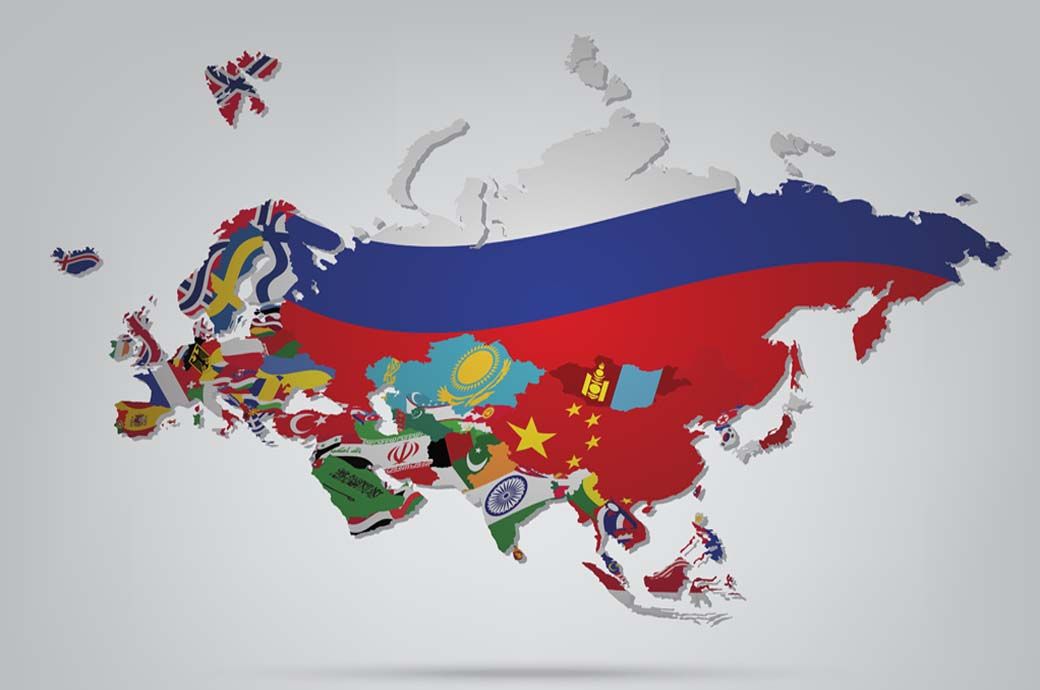

The assertion by the region’s countries of the idea of a multiplicity of cooperation vectors, coupled with a shift in trade and economic ties toward the Asian region, including ASEAN, South Asia and the Middle East, give rise to new priorities and interaction formats.
The report introduces 12 applied solutions for enhancing economic cooperation across the Eurasian landmass. While not exhaustive, the list encompasses proposals related to the development of physical infrastructure (transport, the water and energy complex and food logistics), trade, finance (including sustainable finance) and educational cooperation.
Proposals related to the establishment of the Eurasian Transport Network entail the integrated development of international east-west and north-south transport corridors and routes and ensuring their synergy. This necessitates joint infrastructure projects and investments, coordination of national infrastructure development plans and cooperation in enhancing soft infrastructure.
As per the report, creating an integrated Eurasian transport connectivity map will enable the visualisation of key transport corridors and routes crossing the region while preparing a database (observatory) of transport projects for use by international banks and development programmes.
Utilising a cross-border public-private partnership mechanism can enhance cross-border connectivity among Eurasian countries, contingent on intergovernmental agreements and investment sourcing. The involvement of multilateral development banks in such projects is instrumental – they can participate in syndicates and provide expertise and technical assistance for cross-border PPP projects.
A regional approach to managing water and energy resources in the Aral Sea basin involves the development and implementation of a system of effective regulation principles; the modernisation of existing regional institutions in the water and energy complex; the establishment of an international water and energy consortium and the involvement of a financial operator in its operations; the introduction of regional and country water conservation KPIs; and the establishment of a regional production and service cluster for irrigation equipment.
Tripartite cooperation among Kazakhstan, China and Russia in the Irtysh Basin could tackle the escalating demand for water withdrawals in these nations and the risks of water deficits and declining supply. This would entail the preparation and signing of a tripartite agreement between Kazakhstan, China and Russia on cooperation in the Irtysh Basin, as well as the establishment of an institutional cooperation platform dedicated to water management and environmental protection, says the report.
The development of cross-border power transmission lines holds the potential to eliminate the emerging seasonal deficits of electricity in certain countries while effectively redistributing surplus electricity generation in others. The mechanisms could involve integrating the power grids of interested countries, along with the signing and implementation of pertinent intergovernmental agreements, and the construction of cross-border transmission lines operated on PPP principles.
Prioritising the development of the International North–South Transport Corridor for food logistics entails the advancement of transport infrastructure (railways, roads, seaport terminals, border stations and road checkpoints), logistics capabilities (dry ports, transport and logistics hubs, food storage warehouses, including facilities for cold storage) and soft infrastructure (harmonising transportation and border crossing procedures, digitalising documents and processes, etc).
The development and execution of free trade agreements (FTAs) with developing economies is currently the primary mechanism for bolstering trade and investment ties within Eurasia. Implementation strategies may involve the preparation of FTA+ agreements, encompassing broad sectoral cooperation, and the inclusion of services and investment in agreements.
Movement towards technical compatibility among central bank digital currencies (CBDCs) holds the potential to reduce dependency on international payment infrastructure, establishing a novel trade and financial infrastructure. Ensuring the technical compatibility of national digital currencies and aligning approaches to the design of cross-border payment models in digital currencies, including through participation in international CBDC platforms (such as mBridge and others), would be beneficial.
Strengthening cooperation and coordination among multilateral development banks (MDBs) holds the potential to leverage investments in infrastructure projects and enhance the effectiveness of technical assistance. This cooperation can span seven domains: capital mobilisation; facilitating the development of capital markets; financing in local currencies; cooperation in expert assessment of projects; integration of knowledge and experience; cooperation in technical assistance; and implementation of cross-border projects affecting the interests of several countries.
The proposed solutions include introducing a multilateral green finance mechanism for Eurasian countries, akin to the EBRD’s Green Economy Financing Facility (GEFF), which annually provides over €6.3 billion in mini-credits to more than 190 partner financial institutions in 29 countries. MDBs could develop joint sustainable finance tools through green syndication, cross-guaranteed GSS+ bonds and green credit lines.
The idea of a large-scale academic mobility programme encompasses implementing a grant system to facilitate short-term studies in Greater Eurasia countries; focusing on training qualified engineering personnel for key industries; establishing a consortium of universities; introducing a system for credit recognition under flexible educational exchange programmes; and ensuring multi-component financing for educational programmes by sharing costs between families, universities and governments, with the involvement of businesses.
Fibre2Fashion News Desk (RR)